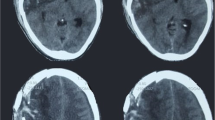Abstract
Between August 1991 and December 1992, CT was performed on 154 patients who had suffered missile head injury during the war in the Republic of Croatia. In 54% CT was performed 1–24 h after injury, and in 27% follow-up CT was also obtained. The wounds were penetrating, tangential or perforating (45%, 34% and 21%, respectively). Haemorrhage was the most frequent lesion in the brain (84%). Follow-up CT evolution of haemorrhage, oedema, cerebritis, abscess, secondary vascular lesions, necrosis, encephalomalacia and hydrocephalus. The most dynamic changes occurred 7–14 days after injury. In 14% of cases, deep cerebral lesions were found in the corpus callosum, septum pellucidum periventricular region and pons, although bone and shell fragments were in a different part of the brain parenchyma. Such lesions were found in penetrating injuries only. CT proved very useful for assessing the extent and type of lesions. Although different mechanisms of brain damage in missile head injury are known, here they are, to the best of our knowledge, shown for the first time by CT.
Similar content being viewed by others
References
Siccardi D, Cavaliere R, Pau A, Lubinu F, Turtas S, Viale GL (1991) Penetrating craniocerebral missile injuries in civilians: a retrospective analysis of 314 cases. Surg Neurol 35: 455–460
Fackler ML, Malinowski JA (1985) The wound profile: a visual method for quantifying gunshot wound components. J Trauma 25: 522–529
Harvey EN, Korr IM, Oster G (1946) Secondary damage in wounding due to pressure changes accompanying the passage of high velocity missiles. Surgery 21: 218–239
Wang Z, Tang C, Chen X, Shi T (1988) Early pathomorphologic characteristics of the wound track caused by fragments. J Trauma 28 [Suppl]: 89–94
Rosenwasser RH, Andrews DW, Jiménez DF (1991) Penetrating craniocerebral trauma. Surg Clin North Am 71: 305–316
Purvis JT (1966) Craniocerebral injuries due to missiles and fragments. In: Ceveness WF, Walker AE (eds) Head injury. Lippincott, Philadelphia pp 133–141
Kirkpatrick JB, Maio VD (1978) Civilian gunshot wounds of the brain. J Neurosurg 49: 185–198
Kirkpatrick JB (1988) Gunshots and other penetrating wounds of the central nervous system. In: Leestma JE, Kirkpatrick JB (eds) Forensic neuropathology. Raven Press, New York, pp 276–299
Kaufman HH, Sadhu VK, Clifton GL, Handel SF (1980) Delayed intracerebral haematoma due to traumatic aneurysm caused by a shotgun wound: a problem in prophylaxis. Neurosurgery 6: 181–184
Haddad FS (1978) Nature and management of penetrating head injuries during the civil war in Lebanon. Can J Surg 21: 233–240
Aarabi B (1988) Traumatic aneurysm of brain due to high velocity missile head wounds. Neurosurgery 22: 1056–1062
Crockard HA, Brown FD, Calica AB, Johns LM, Mullan S (1977) Physiological consequences of experimental cerebral missile injury and use of data analysis to predict survival. J Neurosurg 46: 784–794
Rich NM, Amato JJ, Billy LJ (1971) Arterial thrombosis secondary to temporary cavitation. Surg Digest 6: 12–19
Aarabi B (1989) Causes of infections in penetrating head wounds in the Iran-Iraq war. Neurosurgery 25: 923–926
Brandvold B, Levi L, Feinsod M, George ED (1990) Penetrating craniocerebral injuries in the Israeli involvement in the Lebanese conflict, 1982–1985. J Neurosurg 72: 15–21
Grčević N (1988) The concept of inner cerebral trauma. Scand J Rehabil Med [Suppl] 17: 1–7
Lindenberg R, Freitag E (1960) The mechanism of cerebral contusions. Arch Pathol 69: 440–469
Jadro-Šantel D, Grĉević N, Bešenski N, Kalousek M (1989) The inner cerebral trauma: the correlative pathology with CT scans. In: Aichner F, Gerstenbrand F, Grĉević N (eds) Neuroimaging II. Fischer, Stuttgart, pp 263–273
Bešenski N, Jadro-Šantel D, Grĉević N (1992) Patterns of lesions of corpus callosum in inner cerebral trauma visualized by computed tomography. Neuroradiology 34: 126–130
Hopkins DAW, Marshall TK (1967) Firearm injuries. Br J Surg 54: 344–353
Author information
Authors and Affiliations
Rights and permissions
About this article
Cite this article
Bešenski, N., Jadro-Šantel, D., Jelavić-Koic, F. et al. CT analysis of missile head injury. Neuroradiology 37, 207–211 (1995). https://doi.org/10.1007/BF01578259
Received:
Accepted:
Issue Date:
DOI: https://doi.org/10.1007/BF01578259




